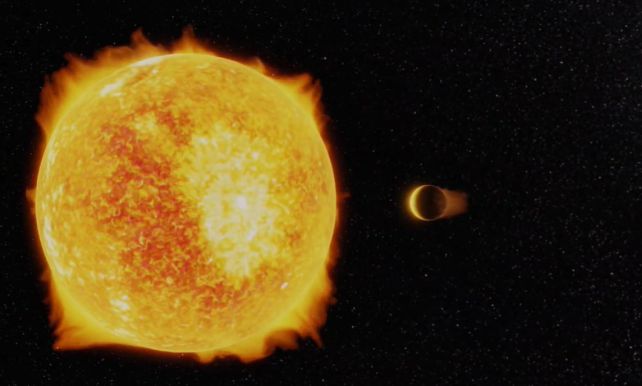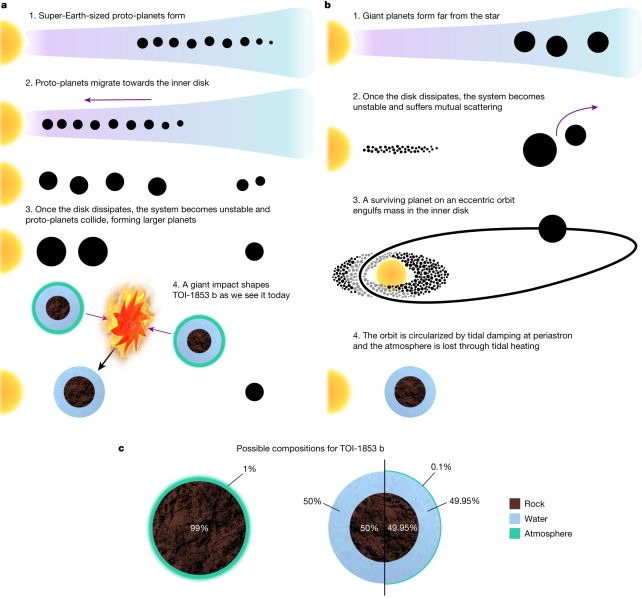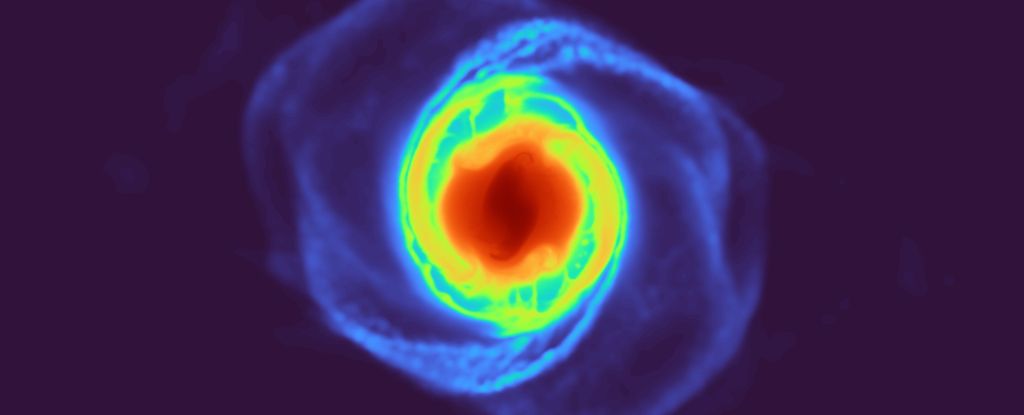Products You May Like
A newly discovered exoplanet has characteristics so peculiar that astronomers think it must have experienced a giant collision some time in its past.
TOI-1853b is an exoplanet just a smidge smaller than Neptune, but nearly twice as dense as Earth, suggesting a composition high in rock that’s challenging to explain through normal planet formation and evolution channels.
Instead, a team – led by physicist Luca Naponiello of University of Rome Tor Vergata in Italy and the University of Bristol in the UK – believes it was once the core of a much larger, gassier world that lost its atmosphere by means of extreme violence.
“This planet is very surprising! Normally we expect planets forming with this much rock to become gas giants like Jupiter which have densities similar to water,” explains physicist Jingyao Dou of the University of Bristol.
“TOI-1853b is the size of Neptune but has a density higher than steel. Our work shows that this can happen if the planet experienced extremely energetic planet-planet collisions during its formation. These collisions stripped away some of the lighter atmosphere and water leaving a substantially rock-enriched, high-density planet.”

TOI-1853b is a rarity among exoplanets. It sits solidly in a gap known as the Neptunian desert – a world around the size of Neptune, on a close orbit with its star.
Just a small handful of worlds that fit this description have been found, of the over 5,500 confirmed exoplanets to date. Figuring out why there are so few exoplanets in the Neptunian desert would help us better understand planetary formation and evolution.
TOI-1853b is 3.46 times the radius of Earth; Neptune is 3.88 Earth radii. But the similarities pretty much end there. The exoplanet orbits its host star, an orange dwarf around 80 percent of the size of the Sun, once every 1.24 days. While its radius doesn’t stretch the imagination too far, its mass is truly baffling: 73.2 times the mass of Earth. Neptune is just 17.15 Earth masses.
At that size and mass, the team calculates, TOI-1853b has a density of 9.7 grams per cubic centimeter. That’s wild. Neptune has an average density of 1.64 grams per cubic centimeter. Earth’s average is 5.15 grams. Iron has a density of 7.87 grams per cubic centimeter, and steel’s density is about the same.
Neptune’s density is so low because it has a thick, extended atmosphere. What TOI-1853b’s density tells us is that its composition must have a lot of denser materials in it, and not much atmosphere. (Also, Earth’s core density is up to 13 grams; material inside a massive body gets compressed by all the mass on top of it, so its density rises.)
Naponiello and his team conducted simulations to determine how in the galaxy a planet could come to be this way. They found that the most likely explanation is a high-speed impact between two massive, still-forming exoplanets that smushed them together and ejected the atmosphere.

“Our contribution to the study was to model extreme giant impacts that could potentially remove the lighter atmosphere and water/ice from the original larger planet in order to produce the extreme density measured,” says physicist Phil Carter of the University of Bristol.
“We found that the initial planetary body would likely have needed to be water-rich and suffer an extreme giant impact at a speed of greater than 75 kilometers per second in order to produce TOI-1853b as it is observed.”
The team plans to conduct follow-up observations to look for traces of an atmosphere around TOI-1853b, and to analyze its composition, to determine whether their collision scenario is likely.
Interestingly, another, similar exoplanet has just been found by another group of scientists. TOI-332b is 3.2 Earth radii, 57.2 Earth masses, on an 18.72-hour orbit around an orange dwarf, and has a density of 9.6 grams per cubic centimeter. Perhaps the two separate teams could combine their efforts.
“We had not previously investigated such extreme giant impacts as they are not something we had expected,” says physicist Zoë Leinhardt of the University of Bristol.
“There is much work to be done to improve the material models that underlie our simulations, and to extend the range of extreme giant impacts modeled.”
The research has been published in Nature.
